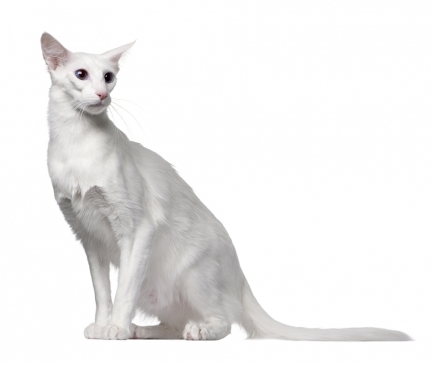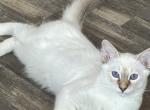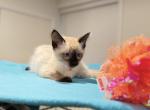

Balinese Cat Breed Description
Balinese Traits At A Glance
Active
Playful
Requires Attention
Affectionate
Vocal
Docile
Intelligent
Independent
Health
Grooming
Child Friendly
Pet Friendly
Hypoallergenic
Size: Medium in size, the Balinese cat breed weighs between 5 to 10 pounds.
Characteristics: The body of the Balinese is identical to the Siamese cat body. They are medium sized, sleek, dainty and graceful-bodied. They are muscular, yet have fine bones. They have long, tapering wedge-shaped heads with medium almond-shaped eyes. They also have very large ears that are wide at the base and pointed at the tip.
Temperament: Balinese temperament is very similar to Siamese temperament. They are loving loyal and bond fiercely to their companions. They will quickly become your best friend and will want to be with you, wherever you are. They will follow you from room to room, be interested in what you are doing, and once you sit down or get comfortable, they will likely nuzzle right in with you. Not only do they want to be where you are, but they want to actively help you and participate in what you are doing. They have voices they are not afraid to use and can be quite opinionated sometimes. They are intelligent, playful, active and will quickly learn new games and tricks. Balinese cats will demand your attention but you will happily give it to them because you will be head over heels in love.
Care: The coat of the Balinese is silky and beautiful and super low maintenance. The coat hardly sheds at all and can be easily taken care of with weekly brushing. The only other grooming the Balinese needs is occasional nail trimming and ear cleaning as well as frequent teeth brushing to prevent periodontal disease.
Coat: The coat of the Balinese is the major different between a Siamese cat and a Balinese cat. They have single layer of coat that is soft, silky and fine. The coat is medium in length and Balinese have tails that have long hair and are quite fluffy. Their coat comes in a wide variety of colors and patterns including seal, blue, chocolate, lilac, red, cream, white with tabby pattern and many more. If you are looking for a hypoallergenic cat then the Balinese cat is a great candidate. They produce less of the Fel D1 protein which is the true cause for your allergic reaction. There is no cat that is 100% allergy free so increasing the frequency of grooming and bathing your furry friend will also help.
Origin: The history of the Balinese cat breed is sparse and largely unknown. There are accounts of cats with similar descriptions from the late 1800s to early 1900s. Siamese breeders started to notice that some longhaired cats were popping up in their litters from time to time, spontaneously. Breeders were unhappy with this finding as they thought it meant that the bloodline was contaminated. As many cat breeds experienced during various wars, the Siamese suffered and almost became extinct during World War I.
Wartime is hard on everyone and perpetuating cat breeds was of little importance during the time so they went largely neglected. It is thought that perhaps during this time, as breeders began to try to save the Siamese cat breed, they introduced other longhaired cats to help grow the breed again. It is widely thought that the Turkish Angora may have been bred with the Siamese because the Turkish Angora has a very similar long, silky coat to the Balinese. Gradually, longhaired Siamese began to be accepted among cat fanciers and a concentrated breeding effort began in the 1940s. Siamese breeder Helen Smith worked fellow breeder, Sylvia Holland and began to develop what we now know as the Balinese cat breed. As longhair breeding grew in popularity, other breeders began to take notice and participate in breeding as well. As often happens when changes in breed standards occur, Siamese breeders voiced their strong opposition to encouraging a longhair breed as they were concerned about contaminating blood lines. To give the breed a much needed fresh start, Helen Smith gave the name Balinese to the breed because the grace and lines of the cats reminded her of dancers from Bali. Now the breed could stand on its own, separate from the Siamese breed.
Soon the breed standard was written and the description was quite similar to that of a Siamese cat, but with long hair. At first, the breed allowed only four colors: seal, blue, chocolate and lilac but later, in 1979, added red, cream and tabby pattern. And, since then, white has been added as well. The only allowable outcross was with Siamese cats but breeders were often reluctant to allow any of their prized Siamese cats breed with Balinese cats. This held back the breed initially and led to slow progress. In 1970, the CFA granted championship status to the breed and in 1979, TICA recognized the breed. Since then, the breed has enjoyed success and admiration for their beauty and personality.


